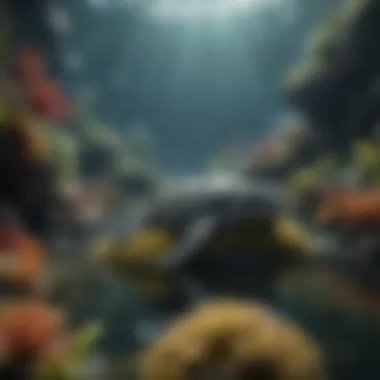Exploring The Nature Conservancy's Global Impact


Overview of the Topic
Environmental conservation has become a pressing concern in today's world, where the delicate balance of ecosystems is continually disrupted. The Nature Conservancy (TNC) stands at the forefront of this struggle, employing innovative approaches to preserve vital natural resources and support sustainability. This introduction not only sets the stage for a deeper investigation into TNC's initiatives but also highlights the importance of this organization's work.
The significance of environmental conservation cannot be overstated, as it encompasses the preservation of wildlife and habitats, addressing climate change, and ensuring future generations have access to the planet's resources. Maintaining biodiversity is crucial, not just for the health of our planet, but for humanity's survival itself. TNC's extensive efforts play a critical role in sustaining these resources while promoting practices that allow ecosystems and communities to thrive.
Current Status and Challenges
As we analyze the contemporary state of natural resource management, it becomes evident that various challenges persist. Climate change, habitat destruction, and overexploitation of resources are at the top of the list of threats facing our environment. Species extinction is alarmingly rapid; many plants and animals are facing unprecedented pressures, leaving them vulnerable to disappearing altogether. The repercussions of these issues ripple through ecosystems, affecting food security and the livelihood of countless communities.
Moreover, the COVID-19 pandemic has exacerbated existing problems, revealing weaknesses in global conservation efforts. Resources are stretched thin, and many organizations, including TNC, must adapt to this new landscape. In light of these challenges, the necessity for innovative strategies and solutions grows more pressing.
Sustainable Solutions
To combat the current challenges, TNC has developed an arsenal of sustainable practices and solutions. For instance, their work in promoting sustainable agriculture focuses on balancing the needs of farmers with the requirements of the environment. Through education and improved farming techniques, TNC enables communities to increase productivity while decreasing their ecological footprint.
Some successful case studies include:
- The Amazon Fund: Supporting sustainable land use practices and protecting the rich biodiversity in the Amazon rainforest.
- Global Marine Initiative: Aiming to establish marine protected areas that enable fisheries to recover while fostering biodiversity.
These examples underline TNC's commitment to not just addressing the current ecological crises, but creating resilience against future challenges. Tools such as conservation easements and sustainable resource partnerships also underscore TNC's multi-dimensional strategy to achieve enduring environmental sustainability.
Impact and Importance
The impact of TNC’s work extends far beyond mere statistics; it touches the lives of individuals and communities worldwide. By conserving vital ecosystems, TNC enhances the capacity of these environments to provide clean air, fresh water, and biodiversity. This, in turn, contributes significantly to the health and well-being of populations dependent on these resources.
Additionally, TNC’s initiatives foster a greater sense of environmental stewardship among communities, encouraging sustainable practices that benefit both people and the planet. Preserving biodiversity and promoting conservation practices is not merely an environmental concern; it is a responsibility we share for future generations.
"The Nature Conservancy believes that nature is essential to our future, and protecting nature is key to protecting ourselves."
Prelude to The Nature Conservancy
The Nature Conservancy plays a pivotal role in the realm of environmental conservation, representing a powerful force for the preservation of our planet's natural resources and biodiversity. Understanding this organization is vital, not just for professionals in conservation, but for anyone who cares about the future of our ecosystems. The complexities of climate change, habitat destruction, and pollution intertwine to threaten the very foundation of life on Earth. Therefore, it becomes increasingly important to explore how The Nature Conservancy (TNC) addresses these challenges through its innovative approaches and extensive network.
Historical Background
Founded in 1951 by a small group of visionaries, The Nature Conservancy has evolved from a grassroots campaign to a global leader in environmental conservation. The organization began with a mission to protect significant lands in the United States but has since expanded its horizons to include diverse ecosystems around the globe.
In its early days, TNC focused on acquiring critical pieces of land that functioned as refuges for wildlife. Over the decades, it has broadened its scope, actively engaging in scientific research, policy advocacy, and community collaboration.
One landmark milestone was the establishment of the first-ever land trust in New York, which set a model for future conservation efforts. The effectiveness of these early strategies laid a solid foundation for the organization to scale its efforts, realizing that biodiversity cannot thrive in isolation. By 1990, TNC had begun to venture into international projects, marking its global footprint. The organization's history is not merely a timeline of events; it's a tapestry woven with the threads of commitment, ambition, and a strong desire to preserve the Earth for future generations.
Core Mission and Vision
At the heart of The Nature Conservancy lies a concise yet profound mission: to conserve the lands and waters on which all life depends. Their vision encompasses a world where nature and people thrive side by side. This dual focus underscores the belief that humanity cannot flourish without a healthy planet.
TNC operates on the principle that conservation should be informed by science and executed through collaboration. They partner with governments, communities, and individuals, recognizing that local stakeholders are often the best advocates for their environments. This approach not only fosters sustainable practices but strengthens community ties.
The organization's work demonstrates the interconnectedness of ecosystems, showing how preserving biodiversity can also lead to improved natural resources for human use. For instance, protecting forests not only safeguards wildlife but also plays a significant role in mitigating climate change through carbon sequestration. By advocating for sustainable practices, TNC enables people to lead more environmentally-friendly lives.
In summary, The Nature Conservancy stands as a testament to the power of collective effort in addressing ecological challenges. As the organization continues to evolve, its foundational principles inspire ongoing research and practical solutions that align ecological integrity with societal needs.
"Our mission is simple: conserve the lands and waters on which all life depends."
Global Conservation Strategy
The concept of a global conservation strategy stands at the heart of The Nature Conservancy's efforts to preserve our planet's delicate ecosystems. With the world facing myriad environmental challenges, including climate change and habitat destruction, a well-defined strategy is paramount. This framework ensures that resources are allocated effectively and that actions are grounded in scientific research. TNC's strategy encompasses both immediate actions and long-term planning, showing consideration of how every effort connects to the larger tapestry of global ecology.
Ecosystem Protection
Land Conservation Methods
Land conservation methods are a key aspect of TNC’s approach. By focusing on preserving natural habitats, TNC addresses the ongoing challenge of land degradation and its link to biodiversity loss. These methods include the establishment of protected areas, conservation easements, and sustainable land management practices.
Key characteristics of land conservation include the use of scientific data to identify crucial areas for biodiversity, which helps in prioritizing conservation efforts. This aspect is not just beneficial; it's essential. The thriving ecosystems in these protected areas serve as refuge for countless species and provide critical services to communities.
One unique feature of these methods is the integration of community needs into conservation plans. This participatory approach ensures local populations benefit from the preservation initiatives while maintaining ecological integrity. However, challenges exist, including the need for ongoing funding and support to manage these areas effectively.
Marine Conservation Efforts
On the flip side, marine conservation efforts are equally vital. With oceans covering about 71% of the Earth, protecting marine ecosystems is crucial for maintaining global biodiversity. TNC employs strategies like marine protected areas, sustainable fishing practices, and habitat restoration projects to combat the threats posed to marine life.
Highlighting the key characteristics, marine conservation efforts not only seek to protect species but also aim to restore habitats such as coral reefs and mangroves — ecosystems that are bursting with life but increasingly at risk. These initiatives have gained popularity among conservationists due to their potential for promoting healthy marine environments.
A distinct feature is the collaboration with local fishers and coastal communities, enhancing their livelihoods while safeguarding marine resources. The downside, however, can be seen in the political challenges and conflicts of interest that may arise when conservation efforts intersect with local economies dependent on fishing.
Community Engagement
Local Partnerships
Local partnerships are an integral thread in the fabric of TNC’s conservation strategy. By collaborating with communities, conservationists can leverage local knowledge, making efforts more effective and culturally relevant. These partnerships engage a diverse range of stakeholders, from indigenous groups to local landowners, aligning conservation goals with community interests.
A key characteristic of local partnerships is the emphasis on mutual benefits. This collaboration helps to build trust and foster a shared sense of ownership over conservation initiatives. It becomes a win-win scenario — the environment is protected, and communities gain sustainable economic benefits.


However, challenges arise when community interests conflict with broader conservation goals. Navigating these waters requires sensitivity and adaptability to maintain positive relationships and avoid alienating local populations.
Grassroots Mobilization
Grassroots mobilization represents another crucial element in fostering community engagement. This process involves rallying community members to actively participate in conservation efforts at the local level. Through campaigns, workshops, and education, TNC empowers individuals to advocate for environmental sustainability.
The key characteristic here is the grassroots approach, which amplifies the voices of those often overlooked in traditional conservation narratives. This method not only galvanizes support for initiatives but also cultivates a deeper connection to nature among community members.
Despite its benefits, grassroots mobilization can face hurdles. Mobilizing diverse groups requires significant effort to address varying interests and levels of awareness about environmental issues, making it vital for TNC to be patient and persistent in its efforts.
Key Projects and Initiatives
The Nature Conservancy (TNC) has garnered significant recognition for its pioneering projects and initiatives that drive tangible results in conservation. These efforts go beyond mere preservation to include restoration and sustainable management of ecosystems. By focusing on key projects and initiatives, TNC demonstrates how proactive measures can yield benefits not only for nature but for communities reliant on these resources as well. These projects serve as practical examples of how integrated approaches in conservation can address current environmental challenges.
Restoration Projects
Reforestation Efforts
Reforestation is not just about planting trees; it’s a multifaceted endeavor aimed at restoring ecosystems, improving biodiversity, and mitigating climate change. TNC's reforestation efforts target areas previously devastated by logging, wildfires, or disease, showcasing their commitment to reviving forests that support varied wildlife. The key characteristic of these efforts is their focus on native species, which are more likely to thrive in local conditions and support existing wildlife, setting a standard for ecological balance.
A unique feature of TNC's reforestation strategy is the integration of community involvement. Local residents participate in planting and caring for new trees, fostering a sense of stewardship and responsibility for their environment. This hands-on approach not only enhances the success rate of the reforestation projects but also empowers local communities.
However, challenges remain, such as ensuring the long-term health of replanted areas. Some researchers express concerns that rapid growth does not compensate for the loss of complex ecosystems. Despite this, the advantages—like improved air quality and carbon sequestration—make reforestation a crucial aspect of TNC's conservation narrative.
Wetlands Restoration
Wetlands are among the most productive ecosystems on the planet, providing essential services like flood control, water purification, and habitat for countless species. TNC's wetlands restoration projects aim to rehabilitate these vital areas that have been degraded by urban development or agricultural practices. These efforts not only restore habitats but also enhance the resilience of ecosystems to climate change.
A standout characteristic of wetlands restoration is the focus on hydrology. TNC works to restore natural water flows, which is paramount in ensuring that these areas can support diverse plant and animal life. The unique feature of this approach lies in its ability to reduce flood risk while improving water quality, making it a dual benefit for both nature and communities.
However, managing wetlands restoration can be challenging due to land ownership complexities and regulatory hurdles. There can also be pushback from agricultural interests worried about restrictions. Still, the myriad benefits, including greater biodiversity and improved water quality, highlight why wetlands restoration is vital to TNC's mission.
Judicious Resource Management
Sustainable Agriculture
Sustainable agriculture practices are designed to meet food production demands while protecting the environment. TNC advocates for such practices as part of its broader resource management initiatives. Focusing on soil health, crop diversity, and efficient water use, sustainable agriculture represents a holistic approach to farming.
Its key characteristic is the promotion of methods that reduce chemical inputs and increase biodiversity on farms. This not only helps the environment but also ensures the long-term viability of the land for future generations. Unique features like crop rotation and polyculture are common strategies to enhance soil fertility and resilience against pests.
While challenges exist such as transition costs for farmers and potential yield reductions in the short term, the long-term advantages, such as improved soil health and reduced greenhouse gas emissions, illustrate why sustainable agriculture is a linchpin in TNC's conservation framework.
Water Resource Management
Effective water resource management is a pressing issue, especially in areas facing droughts or water scarcity. TNC employs an integrated approach, focusing on the protection of watersheds and the efficient use of water resources. This includes partnerships with local governments and communities to promote practices that safeguard water sources.
A key characteristic of TNC’s water resource management is its emphasis on data-driven decision-making. By employing advanced modeling and monitoring techniques, TNC assesses the health of water systems and identifies critical areas needing protection. Unique aspects such as creating buffer zones and restoring natural flows serve as innovative methods to enhance water quality and habitat.
Despite the hurdles of regulatory challenges and competing interests, the advantages of increased water security and biodiversity highlight the importance of water resource management in TNC's conservation portfolio.
Biodiversity and Ecosystem Services
Biodiversity and ecosystem services form the bedrock of ecological health and sustainability. Understanding these concepts is vital not only for conservationists but also for society as a whole. Biodiversity refers to the variety of life forms on Earth, from the tiniest microbes to towering trees and complex ecosystems. In contrast, ecosystem services are the benefits obtained from these biological systems, encompassing everything from clean air to pollination of crops.
The significance of these interconnected areas can hardly be overstated. Biodiversity ensures resilience in ecosystems, enabling them to withstand and adapt to changes such as climate fluctuations. Diverse ecosystems can provide a wealth of resources and services that sustain human life, economies, and the environment alike. In the words of a well-known ecologist, "the more we understand biodiversity, the better we can protect our natural world."
Importance of Biodiversity
Biodiversity is humanity's lifeline. It supports the food chains and ecosystems that directly affect human survival. Every species, no matter how small, plays a role in maintaining ecological balance. For example, a single species can alter the nutrient cycle in its habitat, influencing everything from soil health to plant growth. Moreover, biodiversity is key to scientific discovery and innovation, often providing clues for developing new medicines and technologies.
One crucial consideration is that a loss of biodiversity can trigger a domino effect. When a species disappears, the consequences can ripple through the entire ecosystem, leading to further losses and diminishing resource availability for us humans. Therefore, conserving biodiversity isn't just an environmental or ethical issue; it's central to global health and security.
Ecosystem Services Provided by Nature
Pollination
Pollination is an often overlooked but essential ecosystem service. It plays a pivotal role in the reproductive process of many plants, including a vast number of crops that humans rely on for food. Bees, butterflies, and even some birds and bats are all vital pollinators that contribute to maintaining biodiversity and food security.
A key characteristic of pollination is its specificity; different species of pollinators are attracted to different types of plants. This specialization makes understanding local ecosystems critical for enhancing pollination services. The unique feature of pollination is that it often requires a healthy habitat. If natural landscapes are degraded, the ability of pollinators to thrive also diminishes, leading to a decline in plant diversity and agricultural yields.
Climate Regulation
Climate regulation is another crucial service provided by nature. Healthy ecosystems like forests, wetlands, and oceans act as carbon sinks, absorbing carbon dioxide from the atmosphere and mitigating the effects of climate change. The ability of these ecosystems to regulate climate is a significant factor in maintaining global temperatures and weather patterns.
As temperatures rise, ecosystems like mangroves and salt marshes not only store carbon but also protect coastal areas from extreme weather events, such as storms and rising sea levels. However, the unique aspect of climate regulation is that it can be disrupted by human actions, such as deforestation or pollution, potentially leading to catastrophic feedback loops.
Water Filtration
Water filtration is an ecosystem service that is frequently taken for granted. Natural water bodies like wetlands and forests act as filtration systems, removing pollutants and contaminants from water before they reach rivers, lakes, or aquifers. This service is vital for ensuring that communities have access to clean water.
One unique feature of natural filtration systems is their complexity. Each layer of soil and plant life contributes to filtering out harmful substances and sediments, creating a multi-layered defense against pollution. However, urbanization and land-use changes often compromise these systems, leading to pollution of drinking water sources, with dire consequences for human health.
"The solutions for our environmental issues often lie in the natural functionalities of ecosystems; understanding these services is the first step in conservation."
Threats to Natural Resources


In the context of global conservation, understanding the threats to natural resources is crucial. These threats speak directly to the challenges The Nature Conservancy faces daily in its mission to safeguard biodiversity and the ecosystems upon which our collective survival depends. Recognizing and addressing these threats fosters a more resilient approach in conserving our planet's irreplaceable treasures.
Climate Change
Climate change represents perhaps the most formidable threat encountered today. Rising temperatures, fluctuating weather patterns, and shifting climate zones alter habitats and disrupt natural processes. Wildlife species are thrown into disarray, struggling to adapt quickly enough to survive these environmental upheavals. For instance, polar bears in the Arctic are facing a stark reality as melting ice limits their hunting grounds. Furthermore, climate change exacerbates water scarcity, leading to a decline in agricultural productivity and straining food systems globally.
The interplay between climate change and human actions cannot be ignored. Urban expansion and over-reliance on fossil fuels have accelerated greenhouse gas emissions. Addressing this requires a multi-layered approach: reducing emissions, enhancing green technologies, and conserving carbon sinks like forests and wetlands. TNC’s initiatives focus on mitigation, working with communities to develop strategies that not only combat climate change but also support local economies.
Habitat Loss
The encroachment of agriculture, urban development, and infrastructure projects contributes significantly to habitat loss. When forests are cleared, wetlands drained, or grasslands paved over, consequences unfold which ripple through ecosystems. Animals lose their homes, plant diversity diminishes, and the balance of nature is disrupted. An example that illustrates this issue is the deforestation in the Amazon Rainforest, where species such as the jaguar face the threat of extinction.
Moreover, habitat fragmentation poses additional risks. Even when some habitat remains, corridors between them may become severed, making it harder for species to migrate, mate, and thrive. TNC emphasizes the importance of land conservation, working on restoring habitats and connecting fragmented ecosystems, allowing wildlife to flourish once again.
Pollution and Degradation
Pollution impacts ecosystems and human health alike, affecting air, water, and soil quality. Industrial activities and agricultural runoff contribute to toxins in our environment, leading to severe repercussions. For example, in many regions, fertilizers and pesticides find their way into waterways, resulting in harmful algal blooms that choke out aquatic life and jeopardize drinking water supplies. This creates a vicious cycle, as the benefits of natural ecosystems shrink, aggravating the pollution problem.
Degradation of lands through unsustainable practices further complicates the issue. Overgrazing, deforestation, and overexploitation of resources lead to soil erosion and loss of fertility, making it increasingly difficult to restore these lands. TNC engages in restoration projects aimed at rejuvenating degraded landscapes while promoting sustainable practices to lessen the overall impact on resources.
The stakes are high; without urgent action, the fabric of the natural world we know today is at risk of unraveling.
In summary, tackling the threats to natural resources is a multifaceted endeavor. Each threat intertwines with others, creating a complex web that conservationists, scholars, and policymakers must navigate. To safeguard our planet's future, we must rally together, implementing effective strategies that address these pressing issues head-on.
Policy Advocacy and Legal Efforts
Importance of Policy Advocacy and Legal Efforts
In the ever-evolving landscape of environmental conservation, policy advocacy and legal efforts play a pivotal role. They shape the frameworks within which nature conservation occurs, providing essential support for initiatives aimed at protecting our ecosystems. Without a robust policy framework, even the most well-intentioned conservation projects can be undermined by lack of funding or political will. TNC's involvement in these areas not only highlights its dedication to preserving the natural world, but also its adaptability to work within complex bureaucratic systems.
Influencing Environmental Legislation
Legislation is the backbone of environmental conservation. It determines how resources are allocated, sets standards for pollution control, and defines protections for endangered species. The Nature Conservancy actively engages with lawmakers, pushing for legislation that supports its goals of biodiversity and sustainability. By creating partnerships with governmental agencies and advocating for responsible policy decisions, TNC ensures that environmental considerations are prioritized.
For instance, the Clean Water Act and the Endangered Species Act in the United States serve as key examples of how effective advocacy can result in meaningful change. Through case studies, we can see how TNC's efforts to lobby for enhanced regulations led to more rigorous protection measures for vulnerable wildlife and their habitats. The process may be slow and often challenging, yet it is critical for establishing long-lasting protections for ecosystems, a mission that TNC staunchly supports.
Promotion of International Treaties
On a global scale, The Nature Conservancy recognizes the significance of international cooperation to tackle environmental issues that transcend national boundaries. Treaties, such as the Convention on Biological Diversity, provide a platform for nations to collaborate and commit to shared conservation goals. TNC plays an influential role in shaping these agreements, ensuring that ecological integrity remains a priority.
The promotion of international treaties involves careful negotiation and a deep understanding of various countries' political climates. Whether it’s facilitating discussions among stakeholders or rallying support to secure commitments, TNC’s advocacy efforts have been crucial. Such treaties can lead to binding agreements that enforce sustainable practices across borders, strengthening global efforts against climate change and biodiversity loss.
"Policies and treaties are not just documents; they represent voices of change for future generations."
Through education and outreach initiatives, TNC also works tirelessly to raise awareness about these treaties. By doing so, it encourages public support for measures that protect the environment and upholds the foundational principles of conservation on an international stage.
In summary, the intersection of policy advocacy and legal efforts embodies TNC's approach to achieving its conservation objectives. By influencing legislation and promoting international collaboration, TNC fosters a more sustainable future for all species on Earth.
Funding and Support Mechanisms
Understanding the funding and support mechanisms that underpin the work of The Nature Conservancy (TNC) is crucial for appreciating how the organization operates and succeeds in its mission. Financial backing is the lifeblood of any conservation effort. TNC relies on various streams of funding to fuel its diverse initiatives worldwide. This financial infrastructure not only facilitates the implementation of high-impact projects but also ensures sustainability in the long term.
TNC’s funding strategies are multi-faceted, incorporating donations from individuals, grants from foundations, and corporate partnerships. Each of these elements plays a significant role in fostering conservation initiatives that address critical environmental challenges. By delving deeper into donor contributions and grants, one can appreciate how keen strategies align with TNC’s core objectives.
Donor Contributions
The realm of donor contributions is not just about monetary transmission; it is a testament to collective commitment towards ecological preservation. Individuals and corporations that donate often feel a sense of ownership towards the projects funded. Their support can range from small one-time donations to substantial annual commitments, providing financial support that TNC counts on to kickstart impactful projects.
- Individual Giving: Many devoted conservationists contribute by becoming TNC members or participating in specific campaigns, such as Protecting Our Planet. These donations create a core funding base, allowing TNC to act swiftly on urgent conservation needs.
- Corporate Sponsorships: Collaborations with businesses create essential partnerships. Corporations contribute funds while often showcasing their commitment to sustainability, impacting their image positively amongst eco-conscious consumers.
Donor engagement is enhanced through informative updates about successful projects, demonstrating the direct impact their contributions make. This encourages a cycle of giving, as satisfied donors are likely to continue supporting once they see tangible results from their investments.
"Conservation is for all of us, and every contribution, big or small, brings us one step closer to our goals". - The Nature Conservancy
Grants and Foundations
Grants from foundations represent another pivotal piece of TNC’s financial puzzle. Many philanthropic organizations share TNC’s vision of ecological stability and extend financial resources to enable ambitious project goals. These grants are often tied to specific causes, which allows TNC to focus its efforts on critical areas that require attention.
- Targeted Funding: Organizations like the Pew Charitable Trusts and the Packard Foundation provide grants focused on particular initiatives like marine conservation efforts or forest restoration. This funding structure allows TNC to capitalize on expertise and target projects with high potential for success.
- Capacity Building: Many foundations also prioritize strengthening TNC’s organizational infrastructure. This includes investments in technology, training, and outreach programs, all vital to ensuring TNC can engage local communities and adapt to evolving environmental challenges.
Case Studies of Successful Conservation
The relevance of case studies in conservation work cannot be overemphasized. These cases provide tangible evidence of what works, offering a roadmap for future initiatives. By analyzing successful projects, stakeholders gain insight into effective strategies and methodologies. Furthermore, they serve as a source of inspiration and motivation for those involved in environmental work globally.
Project Analysis
Renewable Energy Initiatives
Renewable energy initiatives represent a vital aspect of conservation efforts, particularly in reducing the carbon footprint and promoting sustainable practices. Through harnessing the power of solar, wind, and hydropower, TNC has made significant strides in decreasing reliance on fossil fuels. One key characteristic of these initiatives is their focus on community involvement; residents often participate in the planning and implementation stages, which fosters a sense of ownership and responsibility towards the project.
What sets apart these renewable energy projects is their adaptability. Different regions face unique energy challenges, and renewable solutions can be tailor-made to meet local needs. For instance, community solar gardens allow individuals in urban settings to benefit from solar energy without needing a rooftop installation. This type of program has gained traction due to its inclusivity and accessibility.
However, it's important to consider the disadvantages too. Initial setup costs for renewable energy can be high, but many see it as a long-term investment that pays off through reduced energy bills and lower environmental impact. The benefits far outweigh the drawbacks, especially when we acknowledge the urgent need to combat climate change. As we look to the future, it becomes clear that renewable energy initiatives are not just beneficial; they are essential.
Sustainable Fishing Practices
Sustainable fishing practices are another cornerstone in the conservation landscape. These practices focus on maintaining fish populations and ensuring their habitats are preserved, contributing significantly to ecological health. A key characteristic of sustainable fishing is the implementation of catch limits and seasonal closures, which allow fish stocks to recover. By balancing human consumption with ecological integrity, these practices serve both the community and the environment.


The unique feature of sustainable fishing practices lies in their ability to engage local fishermen. Many initiatives involve local knowledge and expertise, making it an inclusive process. Fishermen are not merely regulated; they are part of the solution. This participation fosters a culture of stewardship, where fishers take pride in the health of their marine environment.
Nonetheless, there are disadvantages to consider. Transitioning to sustainable practices can be challenging for fishers who are accustomed to traditional methods. Providing training and resources is essential, but it can require time and financial resources that are not always readily available. However, the long-term benefits—healthier ocean ecosystems and pro-sustainable economic models—make these practices worthwhile.
“Conservation includes a shared commitment to ensuring that natural resources are used responsibly and sustainably. These case studies showcase how collective efforts can lead to meaningful change.”
By examining these case studies, it becomes evident that both renewable energy initiatives and sustainable fishing practices play a crucial role in conservation efforts. They embody the partnership between humanity and nature, hinting at a future where preservation and progress coexist harmoniously.
Public Awareness and Education Programs
Public awareness and education programs are essential components of conservation efforts, particularly those led by organizations like The Nature Conservancy. These initiatives play a vital role in building a community that is informed and proactive about environmental issues. By engaging individuals from various backgrounds, these programs foster a collective understanding that can lead to meaningful action. The goal is to bridge the gap between knowledge and behavioral change. Conservation is not just a niche interest; it's something that affects all of us. Here’s how these programs do that:
Environmental Education Campaigns
Environmental education campaigns are foundational in nurturing a sense of connection to nature. They aim to equip communities with knowledge that empowers them to make informed decisions regarding the environment. By focusing on local ecosystems, these campaigns often tailor their content to reflect the unique environmental contexts of the areas where they are implemented.
- Theme-Specific Approach: Each campaign may tackle specific themes like biodiversity, climate change, or sustainable practices. For example, a campaign focused on recycling might highlight local waste management issues and encourage practices that reduce landfill dependence.
- Use of Multimedia: These campaigns often employ various media—such as posters, social media, and community events—to engage different age groups and demographics. For instance, interactive webinars can capture younger audiences, while community newsletters might resonate with older residents.
- collaboration with local schools: Partnering with schools ensures that environmental education is integrated into curricula, thus influencing young minds early on. Education for youngsters can lead to enduring belief systems around conservation.
"Education is the most powerful weapon which you can use to change the world." – Nelson Mandela
Community Workshops
Community workshops provide an interactive space for individuals to dive deeper into conservation concepts and practices in a hands-on way. They can address specific local challenges while imparting skills necessary to tackle these issues effectively.
- Skill Development: Workshops might include practical skills such as native plant gardening, sustainable fishing methods, or waste sorting techniques. Participants don't just learn; they apply that knowledge in tangible ways that benefit their local environments.
- Facilitating Dialogue: These workshops create forums where community members can voice their concerns and discuss solutions collaboratively, promoting a culture of cooperation.
- Focus on Local Needs: Each localized workshop can address pressing issues specific to the community, inviting participants to collaborate on actionable plans. This specificity helps maintain relevance and encourages turnout.
Collaborations with Other Organizations
Collaborations with various organizations form a cornerstone of The Nature Conservancy's operational framework. This synergy extends across multiple sectors, bringing together governmental agencies, non-profit organizations, and corporate partners. The interconnectedness of these relationships amplifies TNC's impact on conservation efforts greatly.
Benefits of Collaborations:
- Resource Sharing: Joint projects allow sharing of resources, whether that be funding, human capital, or technical expertise. This pooling of resources can lead to more robust, well-rounded initiatives.
- Broader Reach: By partnering with other organizations, TNC can tap into established networks, thus reaching a wider audience and driving greater awareness of conservation issues.
- Diverse Perspectives: Engaging with diverse entities brings in different skill sets and areas of expertise, enhancing problem-solving capabilities. This mix can lead to innovative solutions to complex environmental challenges.
However, it is essential to approach these collaborations with careful consideration of shared values and goals among all involved. Misaligned objectives can undermine the purpose and effectiveness of any partnership.
Global Partnerships
Global partnerships symbolize the international spirit of conservation. TNC collaborates with other leading environmental organizations, such as the World Wildlife Fund and the Conservation International, to tackle issues like climate change and habitat preservation on a broader scale.
These collaborations enable TNC to leverage global knowledge and practices, harnessing insights from various ecosystems around the world. Many of these partnerships unfold at major environmental conferences, leading to agreements that lay the groundwork for joint initiatives. For instance, collaborations focused on protecting the Amazon rainforest illustrate how combined efforts can mobilize funding, engage local communities, and enact legal protections for vital ecosystems.
"Working with other organizations strengthens our voice in conservation. Alone we can do so little; together we can do so much."
Some key elements of global partnerships include:
- Collaborative research initiatives to better understand ecological challenges.
- Joint fundraising efforts to boost resources for high-impact projects.
- Shared educational programs that help disseminate important conservation knowledge.
Local Collaborations
While global partnerships attract attention, local collaborations often yield significant, tangible results in communities. TNC works closely with local land trusts and community groups to address specific environmental challenges rooted in unique geographic and cultural contexts. These partnerships emphasize the importance of grassroots engagement in conservation.
In places like Appalachia, for example, partnering with local farmers to encourage sustainable agricultural practices demonstrates TNC's commitment to blending environmental stewardship with community needs. Workshops and community meetings facilitate dialogue, leading to tailored solutions that resonate with local stakeholders.
The benefits of local collaborations include:
- Tailored Solutions: Understanding local ecosystems helps tailor restoration and conservation strategies that are effective and culturally appropriate.
- Building Community Resilience: By empowering local communities, TNC fosters practices that enhance community strength in confronting environmental changes.
- Enhancing Local Economies: Sustainable practices can bring economic benefits through ecotourism or alternative farming methods, showing direct local advantage along with environmental benefits.
In summary, collaborations—both global and local—wield considerable influence in amplifying The Nature Conservancy's initiatives. They cement not just TNC’s policies but also bolster local communities' engagement in tackling today's environmental challenges.
Epilogue and Future Directions
In concluding this comprehensive study, it’s vital to highlight the immense importance of understanding the future directions and the impacts of The Nature Conservancy's initiatives. As the global environment faces unprecedented challenges, the role of organizations like TNC becomes increasingly crucial. Their multifaceted approach to conservation addresses not just the surfaces but dives deep into the core of ecological balance, allowing for sustainable practices that resonate with present and future generations.
One significant element to consider is how effective assessment methods can inform future projects. Monitoring and evaluating the success of various initiatives is paramount. Understanding what works is key to scaling and replicating conservation efforts.
Particularly, the following benefits emerge from a robust assessment practice:
- Informed Decision-Making: By analyzing outcomes, TNC can tweak programs and shift focus to areas with greater impact.
- Increased Funding Opportunities: Demonstrating success can attract more donor support, crucial for enhanced resources.
- Enhanced Public Engagement: Clear results can foster greater community involvement in conservation efforts.
Moreover, advancements in technology also play a critical role in shaping future directions. The intersection of conservation and technology has paved the way for innovative practices that enhance TNC's ability to monitor, communicate, and engage with their efforts. This integration varies from satellite imagery used for land assessments to mobile applications that involve local communities in real-time environmental monitoring.
Assessing Impact
A thorough assessment of impact is vital for any conservation organization. It not only measures the outcomes of current initiatives but also serves as a guiding star for future endeavors. The Nature Conservancy employs varied tools and methodologies to evaluate the effectiveness of its projects, ensuring that the information gathered is both comprehensive and actionable.
For instance, metrics include:
- Biodiversity Indices: These help quantify changes in species populations and ecosystems.
- Community Involvement: Measuring community participation rates reflects engagement levels and support for ongoing efforts.
- Ecological Health: Assessing changes in ecosystem resilience aids in gauging sustainability levels over time.
"By looking closely at impacts, we are not merely counting activities; we’re shaping a future that embraces both natural ecosystems and human needs.”
These metrics guide the organization in re-evaluating strategies. They also assist in communicating successes to stakeholders and the public, building a transparent narrative that fosters trust and support. In a world where results can often seem nebulous, tangible outcomes shine a light on the nuanced and impactful work done by TNC.
Advancements in Conservation Science
The future of conservation science is laced with optimism and innovation. As The Nature Conservancy continues to push boundaries, it is important to keep an eye on the scientific advancements that promise to enhance the efficacy of conservation efforts. Techniques derived from modern science are continually being integrated into TNC’s strategies.
- Bioinformatics: Utilizing data analysis to track species and assess ecosystems contributes vitally to conservation planning.
- Remote Sensing Technology: This allows for monitoring vast areas, making it easier to gather data on wildlife movements and habitat conditions.
- Genetic Research: Understanding genetic diversity helps in breeding programs aimed at enhancing resilience among species.
The incorporation of these advancements supports the development of practices that are not only sustainable but also innovative and adaptable. It illustrates the power of a science-based approach in addressing the immediate and long-term challenges posed by climate change and biodiversity loss.
As we reflect on the overarching mission of TNC, it is clear this organization stands poised to leverage its history, partnerships, and scientific prowess to continue leading the conversation on conservation. The path ahead may be littered with obstacles, but equipped with a strong foundation and innovative strategies, TNC is set to navigate future challenges, setting an example for others in the field.



